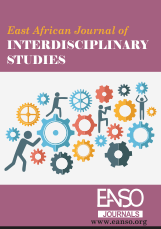National Identity Card and Citizen Inclusion in Uganda
Abstract
The paper argues that the claimed correlation between national identity cards and efficient service delivery is questionable in Uganda. In addition to claims of enhanced efficiency, technology also serves as an instrument of governmentality, increasing the state’s power to control individuals and resources. The paper draws on the global rise of digital identification systems, which is causing interesting and uneven transformations in government identification systems, including in Uganda. Some of the most dominant discourses about digitalisation explain its expansion by claiming that it allows more people to obtain legal proof of identity and enhances the inclusivity of citizens in development programs. Additionally, there are claims that it will help the government improve the delivery of public services and humanitarian assistance through various agencies. However, digital identification technologies, including biometric IDs with features like fingerprints, iris scans, and facial recognition, are instrumental in making citizens visible to the state in new ways, facilitating security and surveillance, and enhancing the state’s ability to control its citizens. The paper investigates such digital transformation in this context by using contemporary Uganda as a case study, drawing on qualitative interviews with key actors, mainly citizens located at the interface with local offices of national ID registration bureaucracies. It analyses contradictions in the mixed logics of the state associated with the introduction of new ID technologies and their implications regarding service delivery. This raises a question: How does the new national ID system affect the proclaimed efficiency of service delivery?
Downloads
References
Bennett, C. J., & Lyon, D. (2008). Playing the identity card: Surveillance, security and identification in global perspective. Routledge.
Bettcher, K., & Mihaylov, T. (2015). Economic inclusion: Leveraging markets and entrepreneurship to extend opportunity. Center for International Private Enterprise, 26.
Breckenridge, K. (2005). The Biometric State: The Promise and Peril of Digital Government in the New South Africa. Journal of Southern African Studies, 31(2), 267-282. https://doi.org/10.1080/03057070500109458
Breckenridge, K. (2014). Biometric state. Cambridge University Press.
Breckenridge, K., & Szreter, S. (2012). Registration and recognition: documenting the person in world history.
Caplan, J., & Torpey, J. (2001). Documenting individual identity: The development of state practices in the modern world. Princeton University Press.
Ceyhan, A. (2008). Technologization of security: Management of uncertainty and risk in the age of biometrics. Surveillance & society, 5(2).
Flore, L. (2004). World Bank (by)," World Development Report 2004: Making Services Work For Poor People", London, Oxford University Press. Diritto pubblico, 10(1), 385-402.
Foucault, M. (1991). The Foucault effect: studies in governmentality. Harvester Wheatsheaf.
Foucault, M. (2007). Security, territory, population: lectures at the Collège de France, 1977-78. Palgrave Macmillan.
Foucault, M. (2008). The Birth of Biopolitics: Lectures at the Collège de France, 1978-1979. Palgrave Macmillan.
Fourchard, L., & Bardelli, N. (2021). Bureaucracy and the politics of identification in Nigeria: Issuing certificates of indigene and investigating citizens' ancestral origins. In Identification and Citizenship in Africa (pp. 185-202). Routledge.
Gelb & Clark. (2013). Identification for development: The biometrics revolution. Center for Global Development Working Paper(315).
Gelb, A., & Diofasi, A. (2016). Using Identification for Development: Some Guiding Principles. Center for Global Development, 22.
Gelb, A., & Metz, A. D. (2018). Identification revolution: Can digital ID be harnessed for development? Brookings Institution Press.
Gidley, J., Hampson, G., Wheeler, L., & Bereded-Samuel, E. (2010). Social inclusion: Context, theory and practice. The Australasian Journal of University-Community Engagement, 5(1), 6-36.
Golder, B. (2007). Foucault and the genealogy of pastoral power. Radical philosophy review, 10(2), 157-176.
Government of Uganda. (1995). Constitution of the Republic of Uganda. Uganda Print. and Publishing Corporation.
Government of Uganda. (2015). The Registration of Persons Act. Entebbe: Printed by UPPC, Entebbe, by Order of the Government.
Government of Uganda. (2023). On the State of Equal Opportunities in Uganda. T. E. O. Commission.
GSMA, Group, W. B., & Alliance, S. I. (2016). Digital Identity: Towards Shared Principles for Public and Private Sector Cooperation. World Bank.
Hammar, A. (2018). Certifications of citizenship: reflections through an African lens. Contemporary South Asia, 26(2), 238-246.
Kim, K. M., & Hwang, J. H. (2019). Exploring gaps in the online economic inclusion of persons with disabilities in Korea. Information, Communication & Society, 22(4), 570-581.
Li, T. M. (2007). Governmentality. Anthropologica, 49(2), 275-281.
Lyon, D. (2003). Surveillance as social sorting: Privacy, risk, and digital discrimination. Psychology Press.
Lyon, D. (2008). Biometrics, identification and surveillance. Bioethics, 22(9), 499-508.
Lyon, D. (2009a). Identifying citizens: ID cards as surveillance. Polity.
Lyon, D. (2009b). National IDs in a global world: Surveillance, security, and citizenship. Case W. Res. J. Int'l L., 42, 607.
Magnet, S. A. (2020). When biometrics fail: Gender, race, and the technology of identity. Duke University Press.
Manby, B. (2018). Statelessness and Citizenship in the East African Community. Available at SSRN 3783292.
Mann, M., & Daly, A. (2019). (Big) data and the North-in-South: Australia’s informational imperialism and digital colonialism. Television & New Media, 20(4), 379-395.
Martin, A., & Taylor, L. (2021). Exclusion and inclusion in identification: Regulation, displacement and data justice. Information Technology for Development, 27(1), 50-66.
Masiero, S., & Bailur, S. (2021). Digital identity for development: The quest for justice and a research agenda. Information Technology for Development, 27(1), 1-12.
Nabukeera. (2020). Original Paper The Performance of National Identification and Registration Authority in Uganda: 2016–2017. World, 7(3).
Olivier de Sardan, J.-P. (2015). Practical norms: informal regulations within public bureaucracies (in Africa and beyond). In Real Governance and Practical Norms in Sub-Saharan Africa (pp. 19-62). Routledge.
Salamucha, A. (2021). The Concept of Inclusion in the Context of Sustainable Development. Problemy Ekorozwoju, 16(2), 66-74.
Scott, J. C. (1998). Seeing Like a State/James C. Scott. In: New Haven: Yale University Press.
Selwyn, N. (2002). E-stablishing an inclusive society? Technology, social exclusion and UK government policy making. Journal of Social Policy, 31(1), 1-20.
Sen, A. (1999). Development as Freedom, Oxford University Press, New York.
Turner, B. S. (1993). Citizenship and social theory.
United Nations. (1948). Universal declaration of human rights (Vol. 3381). Department of State, United States of America.
United Nations. (2015). Transforming our world: The 2030 Agenda for Sustainable Development. https://sdgs.un.org/2030agenda
World Bank. (2018). Identification for Development Country Diagnostic: Uganda. World Bank.
World Bank. (2020 ). Social Inclusion: Overview. (D. World Bank Washington, Ed.). https://www.worldbank.org/en/topic/social-inclusion/overview
Zakaryan, T. (2020). Report on citizenship law: Uganda. European University Institute
Copyright (c) 2025 Martin Buhamizo

This work is licensed under a Creative Commons Attribution 4.0 International License.




























